Articles
- Page Path
- HOME > Korean J Community Nutr > Volume 24(3); 2019 > Article
-
Research Article
- An Evaluation on the Attitudes and Importance-Satisfaction on Service Quality of University Foodservice among International Students in Busan
-
Kyung Hee Hong
 , Hyun Sook Lee
, Hyun Sook Lee
-
Korean Journal of Community Nutrition 2019;24(3):208-222.
DOI: https://doi.org/10.5720/kjcn.2019.24.3.208
Published online: June 30, 2019
Department of Food Science and Nutrition, Dongseo University, Korea, Professor.
- Corresponding author: Hyun Sook Lee. Division of Food Science and Nutrition, Dongseo University, 47 Jurye-ro, Sassang-gu, Busan 617-716, Korea. Tel: (051) 320-1794, Fax: (051) 320-1781, hyunlee@dongseo.ac.kr
Copyright © 2019 The Korean Society of Community Nutrition
This is an Open-Access article distributed under the terms of the Creative Commons Attribution Non-Commercial License (http://creativecommons.org/licenses/by-nc/3.0/) which permits unrestricted non-commercial use, distribution, and reproduction in any medium, provided the original work is properly cited.
- 1,184 Views
- 10 Download
- 3 Crossref
Abstract
-
Objectives
- This study examined the usage status and the degree of satisfaction of university foodservice (UF) perceived by international students in Busan.
-
Methods
- A questionnaire survey was conducted on the utilization of UF, improvement requirements, preference type and recipe, as well as the importance and satisfaction of UF quality attributes as perceived by international students (n=604) at universities in the Busan area between April and June 2017.
-
Results
- UF was ‘generally satisfied’ or ‘very satisfied’ in about 35.4% of the study population, and ‘not very satisfied’ or ‘not satisfied at all’ in approximately 11.5%. Approximately 21.7% said that UF contributed to dietary life ‘very much’ or ‘quite significantly’ and 36.4% said ‘not very much’ or ‘not at all’. The largest demand for improvement of UF was ‘variety of menu’ (52.0%). The most leftover food in UF was kimchi (30.3%) and broth/stew (19.2%), and the major reason for having leftover was ‘not to one's taste’ (27.8%). After dividing the foodservice quality attributes into 5 factors - food quality and price, sanitation, convenience, physical environment, and service environment - and analyzing the importance and satisfaction of each factor, it was shown that satisfaction was generally lower than the degree of importance. Sanitation factor was high for both importance and satisfaction of UF, while convenience factor was high for the importance but low for satisfaction of UF. Four variables in the food quality and price factor (‘food taste’, ‘freshness of food’, ‘nutritive value of food’, and ‘reasonable price’) and 3 variables in the convenience factor (‘variety of menu’, ‘prompt food service’, and ‘display of the meals for the day’) had high importance but low satisfaction, showing the need for an improvement on these areas.
-
Conclusions
- Based on the study results, it is necessary to improve the food quality, as well as the price and convenience factors, and to provide various menus to increase the satisfaction of UF in international students.
- 1. Korean Ministry of Education. Current status of international students at higher education institutions in 2017 [Internet]. 2017; cited 2017 Sep 29]. Available from: http://www.moe.go.kr.
- 2. Gaowei , Kim SY, Chang NS, Kim KN. Dietary behavior and nutritional status among Chinese female college students residing in Korea. Korean J Nutr 2013; 46(2): 177-185.Article
- 3. Lee HJ, Lee YE, Park EH. Foodservice operational system and satisfaction of customers with foodservice at youth facilities. J Korean Soc Food Sci Nutr 2015; 44(9): 1374-1387.Article
- 4. McCool AC, Smith FA, Tucker DL. Dimensions non-commercial foodservice management. 1st ed. NY, USA: Van Nostrand Reinhold; 1994. p. 39-44.
- 5. Gramling L, Byrd R, Epps L, Keith D, Lick R, Tian R. Foodservice management and its impact college operations: a business anthropological case study. Foodserv Res Int 2005; 16(1): 15-43.
- 6. Hong KH, Lee HS. Study of the dietary behaviors and adaptation for Korean foods among international students in Busan. J Korean Soc Food Cult 2018; 33(2): 112-124.
- 7. Jung HY, Jeon ER. Preference for Korean food and satisfaction of dormitory foodservice by Chinese students studying at Mokpo national university. J Korean Soc Food Sci Nutr 2011; 40(2): 283-289.Article
- 8. Yi NY. Mediating effects of perceived value on the relationship between university foodservice quality attributes and satisfaction of Chinese students in Daejeon. J Korean Soc Food Sci Nutr 2015; 44(11): 1750-1758.Article
- 9. Shin JH. International students recruitment and management in Gyeonggi: focus on Chinese students. Gyeonggi Research Institute; 2012 03. Report No. 2012-04.
- 10. Choi JH, Zhang Y, Zheng H, Zhu X. Affecting factors on the living satisfaction degree in university dormitory's service: focusing on the foreign students of “G” university. J Serv Res Stud 2012; 2(2): 99-113.
- 11. Ryu SH, Cho YH, Han YR. Adaptation for Korean foods and satisfaction for foodservice by different residence periods of Chinese and Japanese university students in Daejeon. J East Asian Soc Diet Life 2014; 24(1): 143-155.Article
- 12. Lim C. Acculturative stresses and adjustment elements of Chinese students' studying in Korea. J Korean Living Sci Assoc 2009; 18(1): 93-112.Article
- 13. Yu L. Study on adaptability and preference of Korean food for Chinese students [master's thesis]. Woosuk University; 2013.
- 14. Gao RR, Kim JH. Changes in dietary life and health-related lifestyle by stress level in Chinese international students in Korea. J Korean Diet Assoc 2018; 24(1): 75-91.
- 15. Lee SJ, Jung HY. Identification of quality attributes of university foodservice and factors required for the improvement of customer satisfaction: a case study using IPA model. J Korean Diet Assoc 2010; 16(3): 208-225.
- 16. Jing Z. Influence of the service quality of university cafeterias on the satisfaction of Chinese students in South Korea [master's thesis]. Daegu University; 2012.
- 17. Fan MM, Bae HJ. Analyzing the importance and satisfaction on the university foodservice selection attributes of foreign Chinese students in Gyeongbuk province. Korean J Food Nutr 2014; 27(1): 128-135.Article
- 18. Yun NY, Choi HS, Lyu ES. Satisfaction of foodservice in high school boarding students in Busan. J Korean Soc Food Sci Nutr 2015; 44(11): 1733-1740.Article
- 19. Choi MK, Choi SH, Lee S. An assessment of customer satisfaction towards university residence hall foodservice and subjective QOL (Quality of Life): focused on the university students in Daegu, Gyeongbuk area. Korean J Community Nutr 2009; 14(1): 114-122.
- 20. Jung HY. A study on utilization and perceived service quality of the university foodservice. J Korean Soc Food Sci Nutr 2013; 42(4): 633-643.Article
- 21. Lee SK. Nutrition management, Cornell dining program. Nutrition and Dietetics; 2015 03. p. 48-51.
- 22. Ren L, Jang JS. A study of dietary life related factor according to the acculturation degree on Chinese students in Korea. Korean J Food Nutr 2017; 30(4): 627-634.
- 23. Lee M, Urkunchiev A, Park S, Aigozhayeva A. Analysis on the cultural adaptation stress of central Asian students in South Korea. J Educ Cult 2015; 21(5): 283-307.Article
- 24. Park SJ, Kim JA, Lee SY. A study on attitude satisfaction of service quality in university foodservices. J East Asian Soc Diet Life 2004; 14(1): 83-91.
- 25. Yi NY. Importance-performance analysis (IPA) of service quality attributes of university foodservice: A comparison of male and female students' perceptions in Daejeon. Korean J Hum Ecol 2012; 21(2): 389-405.Article
REFERENCES
Importance-satisfaction analysis chart for the university foodservice selection attributes

Leftover foods and their reasons and demand for improvement in university foodservice of subjects

The importance and satisfaction levels of the university foodservice by gender
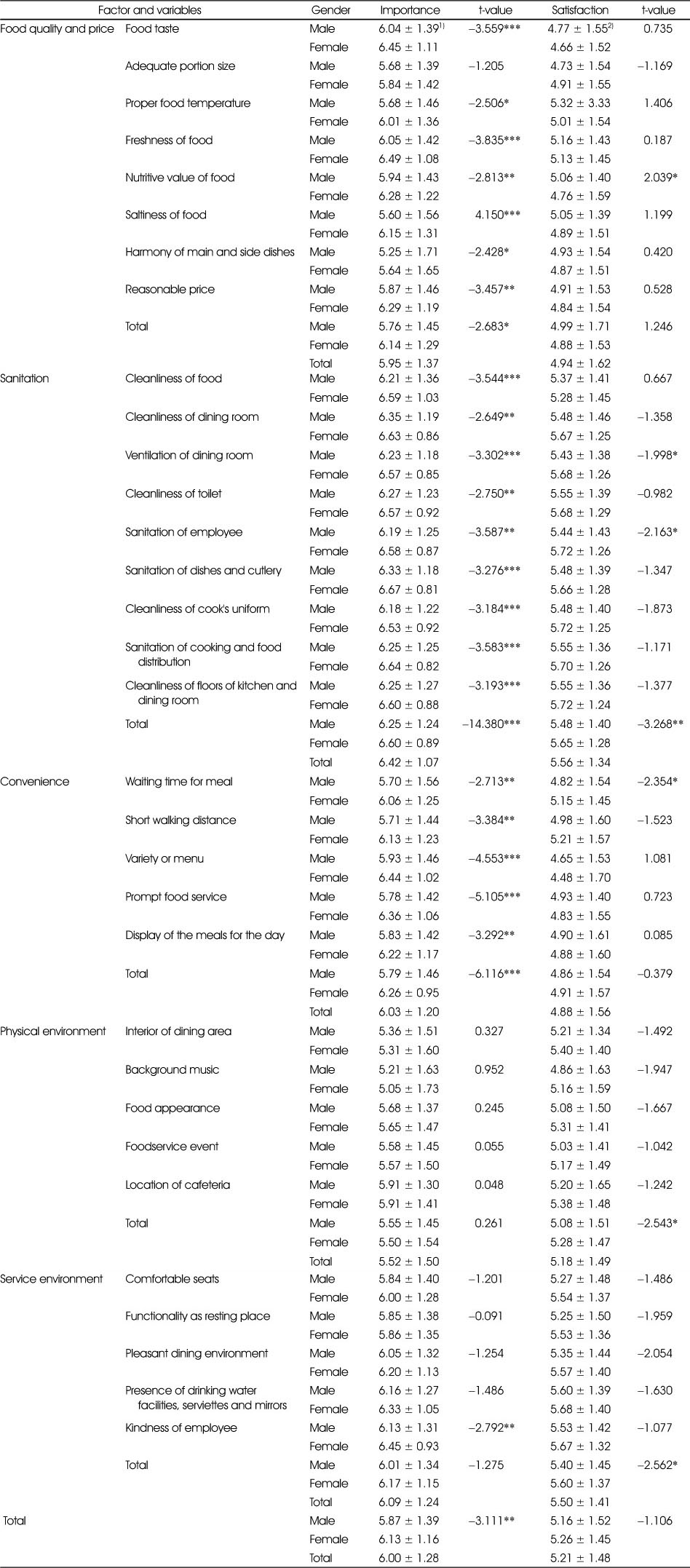
1) Mean ± SD. The importance scores were based on the mean scores measured on a Likert-type scale from 1 to 7 (1: not at all important~4: neither~7: very important).
2) Mean ± SD. The satisfaction scores were based on the mean scores measured on a Likert-type scale from 1 to 7 (1: not at all satisfied~4: neither~7: very satisfied).
*: p<0.05, **: p<0.01, ***: p<0.001
Figure & Data
REFERENCES
Citations

- Development of performance indicators by the Delphi study for foodservice operations in senior welfare centers: application of the balanced scorecard
Gyoungok Gang, Hyeja Chang, Sang-gil Lee
Food Science and Biotechnology.2024; 33(7): 1727. CrossRef - Comparison of consumption behaviors and development needs for the home meal replacement among Chinese college students studying abroad in Korea, Chinese college students in China, and Korean college students in Korea
Mi Ae Bae, So Hyun Park, Siyao Cheng, Kyung Ja Chang
Nutrition Research and Practice.2021; 15(6): 747. CrossRef - Dietary Life of Chinese International Students according to the Frequency of University Foodservice Use in Korea
Yan Cui, Hye-Jong Yoo, Injoo Choi, Jihyun Yoon
Korean Journal of Community Nutrition.2020; 25(4): 291. CrossRef

Fig. 1
General characteristics of subjects
1) Mean ± SD
The usage status of university foodservice of subjects
*: p<0.05
Leftover foods and their reasons and demand for improvement in university foodservice of subjects
**: p<0.01
Preference of materials in food group of subjects
**: p<0.01, ***: p<0.001
Preference of cooking method in food group of subjects
**: p<0.01, ***: p<0.001
The importance and satisfaction levels of the university foodservice by gender
1) Mean ± SD. The importance scores were based on the mean scores measured on a Likert-type scale from 1 to 7 (1: not at all important~4: neither~7: very important).
2) Mean ± SD. The satisfaction scores were based on the mean scores measured on a Likert-type scale from 1 to 7 (1: not at all satisfied~4: neither~7: very satisfied).
*: p<0.05, **: p<0.01, ***: p<0.001
1) Mean ± SD
*: p<0.05
**: p<0.01
**: p<0.01, ***: p<0.001
**: p<0.01, ***: p<0.001
1) Mean ± SD. The importance scores were based on the mean scores measured on a Likert-type scale from 1 to 7 (1: not at all important~4: neither~7: very important). 2) Mean ± SD. The satisfaction scores were based on the mean scores measured on a Likert-type scale from 1 to 7 (1: not at all satisfied~4: neither~7: very satisfied). *: p<0.05, **: p<0.01, ***: p<0.001

 KSCN
KSCN
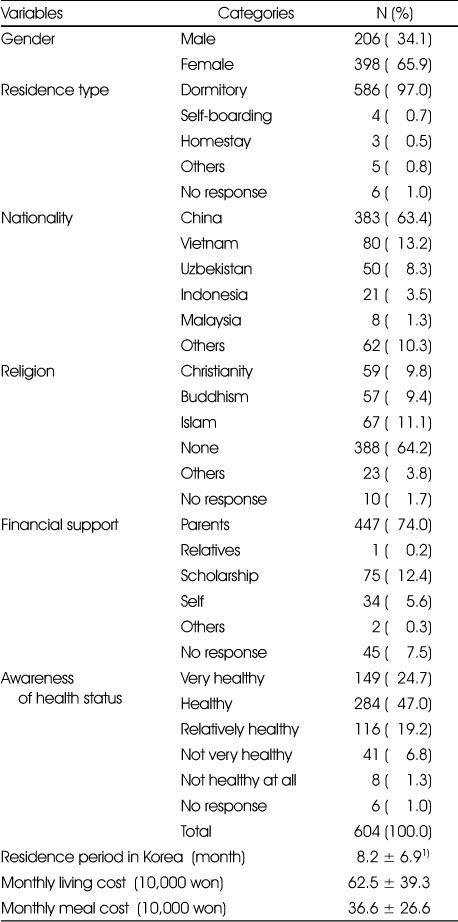
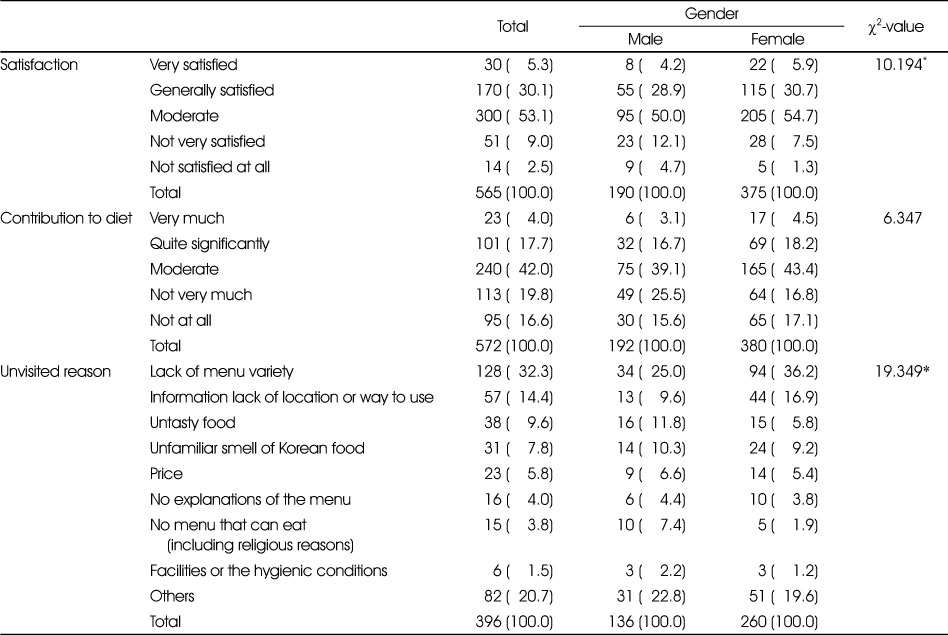
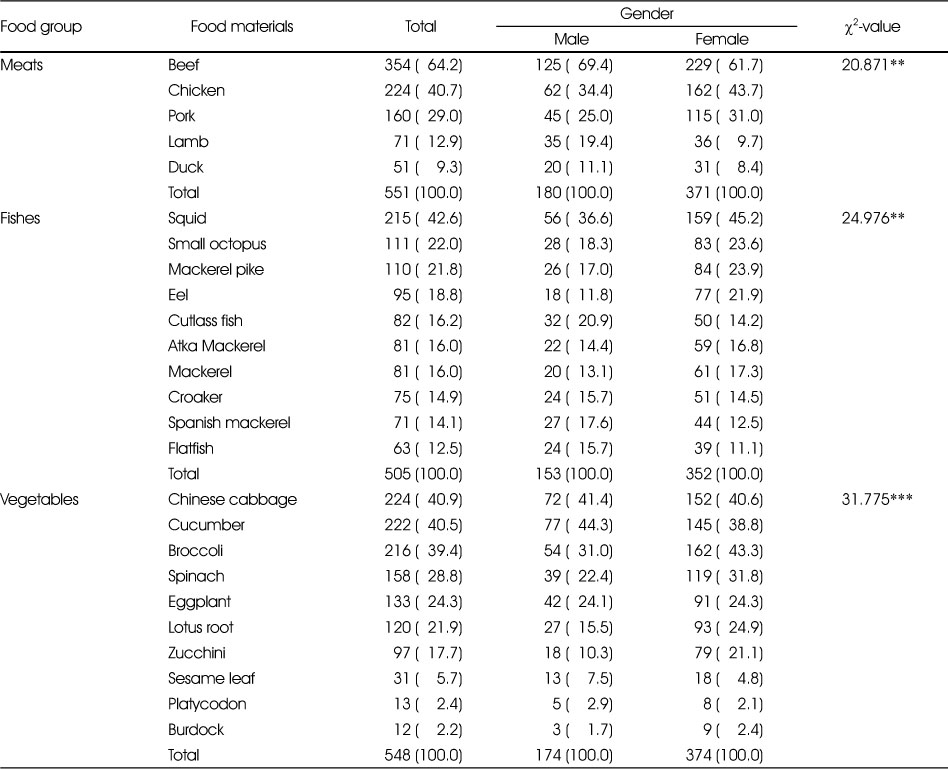
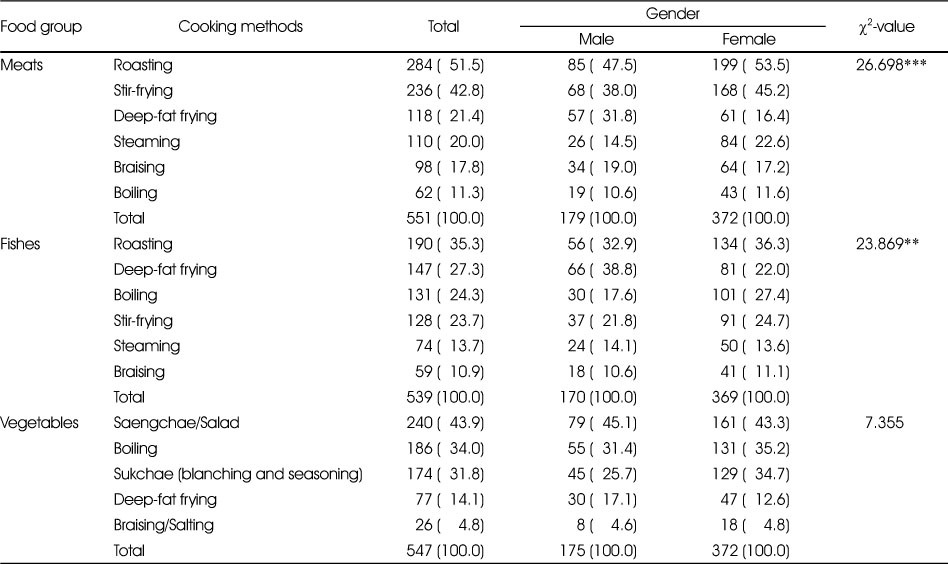
 PubReader
PubReader Cite
Cite


